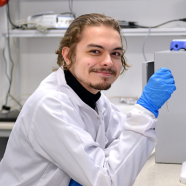Abstract
Semiconductor electrochemistry is a rapidly developing branch of science devoted to understanding the processes at the interface between semiconductors and other materials. This field investigates physiochemical phenomena underlying the working principles of devices such as the solar cells, biosensors, batteries and supercapacitors. These devices are relevant for the most urgent problems of the XXI century, such as the energy crisis and implementation of the personalised medicine paradigm. Due to the complex nature of the phenomena occurring at semiconductor interfaces, fundamental and applied research is required to explore the possibilities to push forward the development of those devices. In this framework, the following thesis is devoted to modifications of titania nanotube (TNT) and boron-doped carbon nanowalls (B:CNW) model semiconductors with polydopamine (PDA) and its copolymers. The main research objective of the thesis is the fabrication of PDA coatings on B:CNWs and TNTs via electropolymerisation, followed by structural and electrochemical characterisations. The obtained composites are optimised towards applications in two strategies: ultrasensitive electrochemical sensing of neurotransmitters, and enhanced photocurrents. The thesis is a collection of four core publications with the dominant contribution of the author in each one. The character of the work is mostly experimental, supported by quantum chemistry calculations. The thesis begins with the outline of the research in the context of global problems in Chapter 1. Then, a comprehensive introduction to the PDA, PZ, B:CNW and TNT materials is presented in the associated literature contexts (Chapter 2). The specific research goals and hypotheses are presented in Chapter 3. The research methodology, including the experimental and computational techniques used in the thesis, is elaborated in Chapter 4. The results of the thesis in the form of a concise framework consisting of four core articles and their discussion are presented in Chapter 5. Finally, the conclusions and prospects for further research are proposed in Chapter 6.
Author (1)
Cite as
Full text
- Publication version
- Accepted or Published Version
- License
- Copyright (Author(s))
Keywords
Details
- Category:
- Thesis, nostrification
- Type:
- praca doktorska pracowników zatrudnionych w PG oraz studentów studium doktoranckiego
- Language:
- English
- Publication year:
- 2024
- Verified by:
- Gdańsk University of Technology
seen 3 times
Recommended for you
Synchrotron radiation photoemission spectroscopy of the oxygen modified CrCl3 surface
- S. Kazim,
- D. Mastrippolito,
- P. Moras
- + 5 authors
Unravelling the role of electron–hole pair spin in exciton dissociation in squaraine-based organic solar cells by magneto-photocurrent measurements
- M. Klein,
- S. Majumdar,
- P. Zassowski
- + 1 authors
Compensation Topologies in IPT Systems: Standards, Requirements, Classification, Analysis, Comparison and Application
- V. Shevchenko,
- O. Husev,
- R. Strzelecki
- + 3 authors


